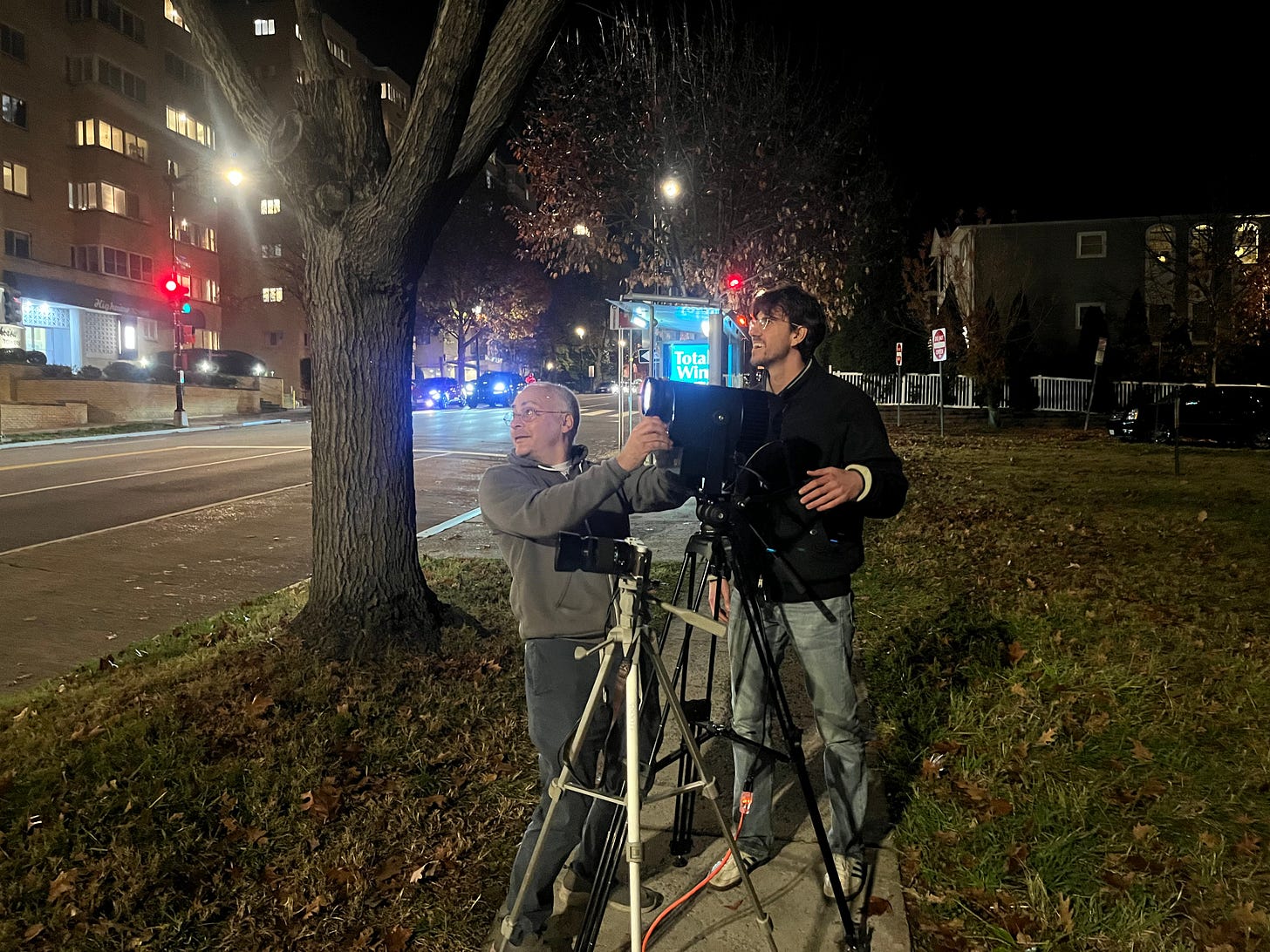#Special Military Operation: Krišs Salmanis
Test successful. Adjustments needed.
Good Morning:









The image is by Krišs Salmanis, a Latvian artist who created it in the early days of the full-scale invasion. It hangs as a giant banner on a museum across the street from the Russian embassy in Riga, Latvia:
I recently wrote to Salmanis, telling him I could do him one better than placing the image across from the embassy. I asked him for permission to place his image on the Russian embassy in Washington DC. He was enthusiastic about the idea.
So that happened over the weekend. My plucky team and I also put it on the Russian ambassador’s official residence, as some of the pictures above reflect.
We, of course, do not project “Z” or “V” images—ever. Those, as always, are countermeasures by the Russian embassy staff designed both to wash out our projection and to confuse people about what our message is.
Normally, I would object to the projection of a “Z” or “V”—which is the rough equivalent of the German embassy in 1938 projecting a swastika on its own walls by way of taunting Jewish protesters. In this case, however, I confess that I found it rather consonant with the projection of Salmanis’s image.
Both convey, after all, that Putin’s Russia is death.
Please share the images widely. No credit, except to the artist, is necessary.
A few notes:
First, I did this operation frankly before I was ready to, because it seemed to me important to remind Americans of the fact that Putin is death in the face of the truly monstrous Trump administration pressure on Ukraine to accept what amounts to a full surrender to him. Our government is now in league with this death head in forcing a genocidal “peace” on Ukraine. When you look at Salmanis’s Putin, remember that we are now allied with this face. Remember that our government no longer objects to the “Z.”
I wrote my “The Situation” column about this over the weekend as well. I cannot express the matter better than I did there, so I won’t try:
what is the morally serious person to feel when his country, over a remarkably short space of time, reorients one of the most fundamental cornerstones of its foreign policy toward colluding with the strong in wiping out the weak?
And what is the morally serious person to feel when his country lays on the table a “deal” that amounts to a capitulation to occupation and domination by an embattled democracy and demands assent within a week from a government wholly reliant on American support?
And what is the morally serious person supposed to feel when that cornerstone of American policy has so evidently changed from supporting the freedom and independence of smaller countries and democracies to support for their conquest and domination by murderous gangsters?
Well, there’s anger, yes. And there’s indignance. And there is that feeling of helplessness again. And there are a lot of other emotions too—worry about friends who don’t have electrical power or heat, for example, and a constant fixation on how one might mobilize limited resources to reduce harm.
But there’s also this shame—this feeling to which I am unaccustomed in thinking about American policy. And this shame is different from the other shames. Because this policy is not a sideshow. And the harm is not a collateral consequence of anything. The harm is the point, the goal. And this shame is also different, because I have no answers to my text correspondents from yesterday, even though America promised answers. I cannot tell them that the asteroid impact isn’t coming or that they will see their families again or that their uncles didn’t die in vain. I cannot even tell them any more that America—however fecklessly, however arrogantly—is on their side.
Because we’re not on their side. We are on the other side.
Since the operation was accelerated over my original plans, it actually served as a bit of a test of a new projector technology—a high-power (300 watt) but quite inexpensive (around $700) gobo projector. The theory here is that investing in high-performance projector technology is unwise, because the police sometimes seize it and don’t give it back and because operations are chaotic and things get damaged. So I’m interested, for the future, in what I think of as a disposable razor approach to future special military operations.
With the help of a very estimable Greek Chorus member, I am also working on bringing down the price of the glass slides (called gobos) that enable these full-color images to be projected at long distances. These are currently rather expensive. (Each one costs around $450.) If we can bring these prices down a bit, we could—at very reasonable cost—have an array of four or five of these projectors, each with a different gobo, some projecting images, some projecting words. And the marginal cost of each operation would be limited to the cost of the gobos in question.
Second, the new projector—her name is Gripen—performed extremely well. The image is bright and clear in full color at a distance of about 100 meters. The “Z” and “V” spotlights were mostly ineffective in interfering with the projection. This means we can now project almost any image, in any combination of colors, on the embassy. And that’s pretty cool.
Third, there is, however, a remaining problem: focus. This is cheap equipment, and the focusing ring on Gripen is not functioning properly. I won’t go into the details but in brief—for the gear heads among you—the threads on the focusing mechanism are tightly fused right now and can’t be loosened by hand, perhaps because on O-ring, or the remains of one, is wedged into them. I am going to try to fix that with graphite and, perhaps, by burning out the O-ring with gentle heat, but unlike my old gobo projector (the late, lamented Himar was a very fancy gal), getting this one in focus in real time at various different distances may pose challenges.
In the case of this weekend’s projection, the solution was human involvement: people actually physically held the lens in place. Here’s the estimable Arkady Dolina and me manually holding the focus in place:
A Great American named Dean did yeoman’s work of a similar nature. And this worked, more or less, but it’s not a good long-term solution. The image drifts in and out of focus with micro movements of hands. So I will be working on Gripen to make her focusing ring work, with further tests to come.
Fourth, another important success in this operation: The United States Secret Service appears not to have changed its view that embassy projections are First Amendment protected speech. This was a point of some doubt in my mind, as the Secret Service’s view of chalk protests certainly has changed, and other law enforcement agencies in Washington have adopted suddenly more aggressive enforcement postures with respect to projections they used to tolerate. That said, Secret Service officers showed up at the scene and did not interfere with our projection. This is a source of considerable relief to me. I admire the embassy protection work the Secret Service does very much, and I am happy to say that the posture of agency towards light projections remains as free-speech protective as it ever has been.
Finally, an important note: People keep asking, “How can we support these efforts?” Short answer: Share the images.
I know, I know. You mean financially, and I really appreciate that. But here’s the thing: You can’t support these operations financially. I don’t want to divert people’s charitable dollars away from organizations supporting Ukraine directly, either through advocacy or through relief activity. There are many good such organizations, and they are doing work far more important than my tinkering and trolling, which I am honored to fund myself.
What you can do, if you like, is to become a paid subscriber to #DogShirtDaily, the proceeds of which effectively fund my democracy-related activity, the Ukraine work included. But please do that because I’m witty and take good pictures and because this stuff makes for great content and because you want to see the #BeastOfTheDay and because “Tell Me Something Interesting” is interesting—and because I have really cool friends and #DogShirtTV is a fucking revolution in morning television. And please don’t do it instead of supporting the hard stuff.
More fun with Gripen is coming soon both at the embassy and . . . elsewhere. Stay tuned. #ExpectMe.
What’s In My Bag?
The estimable Katherine Pompilio and I made another video:
Friday on #DogShirtTV, the estimable
brought on the estimable Stephen Marche to discuss his book on an uplifting topic: the next US civil war. Things got a little testy! It was fabulous.We are definitely having him back.
The Situation
In Friday’s “The Situation” column, I assess new instances of prosecutorial incompetence in the case against James Comey, including a recent revelation that the operative indictment was never specifically seen or approved by the full grand jury.
I could go on, but you get the idea.
It is actually hard to keep up with the pace of developments. Multiple times a day, documents land on this docket that contain new inanities, new abominations in the sight of the law, new factual revelations, new reasons to wonder not whether this case will collapse but only how. At the hearing the other day, Judge Michael Nachmanoff seemed to be struggling with exactly this question, asking an attorney for Comey—in effect—which motion he wants the judge to dismiss the case based on.
Friday On Lawfare
Compiled by the estimable Isabel Arroyo
The Question of Standing in Leaks of Non-‘Salacious’ Data
Irene Loewenson analyzes a Fourth Circuit decision expanding data breach victims’ standing to sue where the information leaked is not “embarrassing or salacious.” Loewenson describes the challenge of determining the concrete harms of data breaches and reflects on how this broader conception of standing might influence companies’ data practices.
In 2021, the Supreme Court held that plaintiffs suing in federal court must point to a common-law analogue for any intangible harms they allege—or else be barred for lack of standing. Since then, circuit courts have diverged on when the harm stemming from data breaches resembles one traditionally recognized under common law. One recurring question is what to do when the leaked information is neutral rather than compromising or salacious. Is the harm of having a driver’s license number wind up in shady corners of the internet close enough to the traditional injury of, say, having an affair splashed across the front page of the newspaper?
On Oct. 14, in Holmes v. Elephant Insurance Company, the U.S. Court of Appeals for the Fourth Circuit answered that question affirmatively. Breaking from sister circuits, the court held that plaintiffs whose driver’s license numbers end up on the dark web after a data breach may sue even though the leaked information isn’t “embarrassing or salacious.” The Fourth Circuit’s approach broadens standing, making it easier for people to sue companies when their personal information surfaces online.
The ‘End of Immunity’ for Leaders Who Commit International Crimes?
Milena Sterio reviews Chile Eboe-Esuji’s “The End of Immunity: Holding World Leaders Accountable for Aggression, Genocide, War Crimes, and Crimes Against Humanity.” Sterio contextualizes and evaluates Eboe-Esuji’s central argument—that customary international law has never recognized immunity for heads of state who commit international crimes while in office—and praises the author’s ability to transform a thorough historical account into a passionate call to action.
Judge Chile Eboe-Osuji’s new book advances a provocative argument: Customary international law does not recognize and has never recognized immunity before international courts for heads of state who commit international crimes while in office. The book addresses a complex and at times technical legal question, yet it offers both a compelling historical narrative and a call to action. Its contribution to the existing literature on immunity thus lies in its ability to simplify a complex area of the law, and to present a forceful claim that world leaders who commit atrocity crimes need to face accountability. In today’s world, where member states of the International Criminal Court (ICC) have refused to cooperate with the court in the arrest and surrender of heads of states with outstanding warrants, and where atrocity crimes continue to be committed on behalf of states, Eboe-Osuji’s book seems particularly timely. It should serve as a valuable resource for all of those interested in international criminal law, and particularly in the law of immunities.
Lessons From the European Airports Ransomware Attack
Rodrigo Pérez-Alonso breaks down how United Kingdom and European Union regulatory architecture shaped responses to the ransomware attack that crippled Heathrow and multiple European airports this September. Pérez-Alonso characterizes American cyber incident response policy as piecemeal by comparison and cautions that discrepancies between U.S. and EU regulations could leave critical transatlantic infrastructure vulnerable to cyberattacks.
The Collins Aerospace incident demonstrates an important aspect of modern cyber threats: Attacks increasingly target not the end user, but the technology providers upon which critical infrastructure depends. This attack was not directed at Heathrow, Brussels, or Berlin; rather, it targeted a single service provider whose systems were embedded in their daily operations. By compromising this centralized service provider, the attackers achieved what would have required separate breaches of dozens of individual organizations, a force multiplier effect.
The attack also exposed the uneven but gradually tightening regulatory landscape that governs cybersecurity across the Atlantic. While the EU has adopted an increasingly centralized approach, the U.S. continues to struggle with piecemeal, sector-specific regulation. In an age of increased cyber incidents, the discrepancy between these approaches could prove detrimental.
AI-Powered Espionage Will Favor China
In the latest edition of the Seriously Risky Business cybersecurity newsletter, Tom Uren discusses why a recent Claude-powered cyberattack suggests artificial intelligence (AI) espionage will appeal to attackers who value scale over precision, Google’s legal disruption campaign against Lighthouse’s phishing-as-a-service, how Google’s adoption of the Rust coding language is mitigating memory safety vulnerabilities, and more.
For threat actors with a high risk appetite or without focus on specific targets, having an AI hacking buddy that stuffs up occasionally is a win if it allows you to do a whole lot more hacking. Think ransomware actors and even state-backed groups hacking for intellectual property. Even if they, and their AI companions, screw up on one promising victim, there are plenty of other fish in the sea.
For threat actors focused on difficult, security-conscious targets, that trade-off is far more risky. There’s only one Vladimir Putin, for example. One meticulous operation is a safer bet than scaled-up attacks with a multitude of mostly automated Claude-brained schemes.
From a state perspective, at least in the short term, we imagine AI-powered hacking campaigns will be adopted by countries that run broad-based hacking campaigns with a high risk appetite: Here’s looking at you, North Korea and China!
Podcasts
On Lawfare Daily, Scott R. Anderson sits down with Joel Braunold and Jeffrey Feltman to discuss Resolution 2803, which the UN Security Council adopted earlier this week to endorse and help implement President Trump’s peace plan for Gaza. The three discuss how the resolution conforms to and departs from typical international practice, what it says about the political positions of various parties involved, and the likelihood it will help end the conflict and inform a potential path to Palestinian self-determination.
Videos
On Lawfare Live, I sat down with Molly Roberts, Roger Parloff, Eric Columbus, and Loren Voss to discuss new court filings in the Comey prosecution, updates in the litigation challenging the federalization and deployment of the National Guard, and more.
Today’s #BeastOfTheDay is the llama, seen here creating awe and bewilderment:
Honorable mention today to the goat; it is also a very worthy animal, but only one Beast can be the #BeastOfTheDay.
Keep reading with a 7-day free trial
Subscribe to Dog Shirt Daily to keep reading this post and get 7 days of free access to the full post archives.






